MPALA TO TBI
After entering the TBI plane, the students flew north towards Ileret to reach the TBI facility. On the way, they saw new horizons and different landscapes that surprised them: remnants of volcanic reactions, a sea of sand that layers the land, and Lake Turkana.
When they arrived in Ileret, the students were welcomed into the grand facility that is the Turkana Basin Institute. After settling in, the first class of the course dived into the history of Kenya. An open discussion arose surrounding the intrusion and change that came from global powers entering Kenya in the late 18th century, and the culture of the Dassanech, the local tribe in Ileret to prepare for the next four weeks. The discussion created an air of respect for the country and its people. This is an imperative start to the program; when attempting to create sustainability in international communities, many organizations present solutions from the perspective of their country or culture. This often creates a one-sided implementation that leaves communities like Ileret with technology or infrastructure that does not suit its surrounding environment. Professor Rodrigo and the Stony Brook students plan to make sustainable initiatives with the impact on the user in mind for the long-term- one of the focal points of this new program.
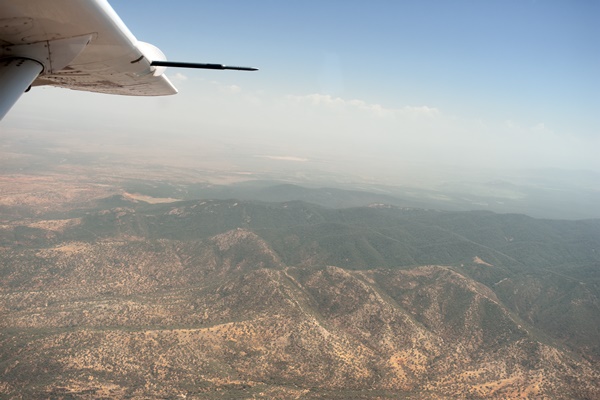
Flying over mountains on the way to Ileret. Photo credit by Cheng-Wen Hsu
The Journey Begins
The summer program is broken up into two parts where students make assessments of the communities’ needs and create short and long term projects from them. The short term projects are to be proposed to the community within the time the students are in Ileret with the goal of providing relief efforts, if there are enough materials and resources to accomplish the task. During this time, students are also considering long-term projects that will provide an appropriate solution to a problem while considering the short, medium and long term effects. To better understand the problems facing the community, Professor Pena-Lang has created a curriculum with a mix of site visits to the nearby town and lectures that teach design process of water collection and treatment, photovoltaic systems, environmental infrastructure, ecology, other forms of renewable energy, and design fundamentals. In the current class, there are civil, mechanical, and engineering science majors as well as a biochemistry/philosophy major and an applied mathematics major. Having both non-engineers and engineers will surely provide new perspectives and develop new mindsets around the vision of the program.
The team embarked on their first site visit at Ileret town to view water collection technology and understand some of the pervasive problems that the community has in its major centers. A windmill that pumps water into the town and water wells with manual pumping units was introduced to the students. The contrast of water scarcity in America as compared to this part of the country was clear. Much of the water wells and water sources in Ileret are heavily doped with fluoride which is natural to the surrounding area. Because of this, people don’t have easy access to purified water, something the students saw as they watched locals wash themselves, their children, and their clothes in the salty liquid.

A windmill that provides most of the water for Ileret town. Photo credit Deming Yang

Students meet locals at the watering pump. Photo credit Deming Yang
The students, energetic and enthusiastic to assist jumped in and helped pump water from the well.
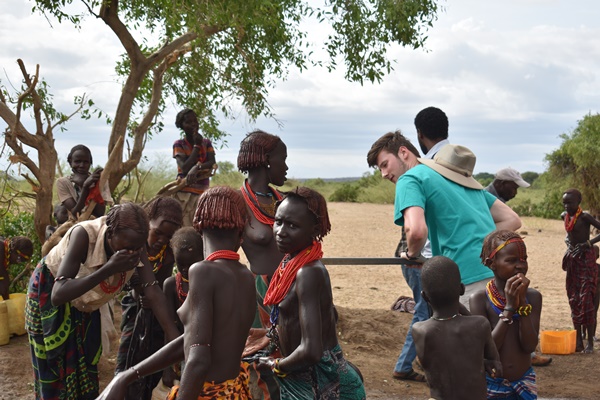
Nick pumping water from the well for the local community. Photo credit Cheng-Wen Hsu
Lastly, they visited the Ileret River, which often runs dry but can cause destructive flooding depending on the season. Here, students observed as locals had dug a hole in the riverbed along the river to collect water for future use. The Global Innovation group grabbed samples of water for testing and communicated with locals. Upon returning, students conducted a discussion about the site visits and brainstormed different processes of obtaining drinking water for the community.

Students interact with locals as water is collected from the riverbed. Photo credit Deming Yang
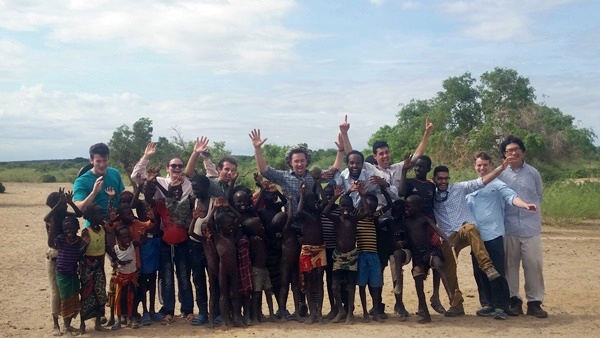
A group photo with some of the local children
From integrating themselves in the local community, the students were able to acknowledge that different standards exist by way of living from their own country. If they were to provide an innovation here, there is a chance that locals wouldn’t be willing to accept it because it might deviate from their long-standing tradition. Students are being faced with the challenge of trying to provide new thinking and innovative solutions while respecting tradition and social values.
During the site visit, a game of soccer erupted with the kids of the community where Global Innovation students showed off some skills and created friendly competition with kids of the community- a good end to the day.
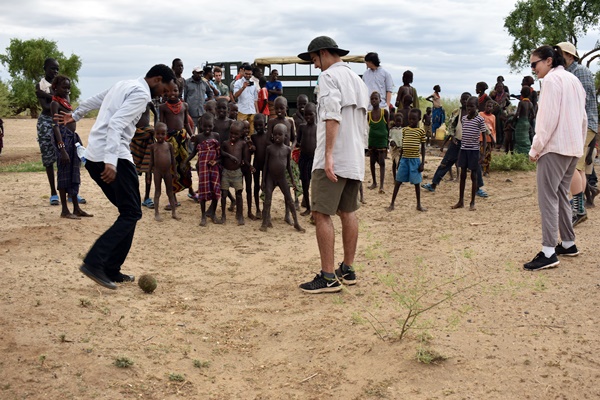
Keena(left) receives the ball from Brent(middle) as Saffron(right) gets ready to receive. Photo credit Cheng-Wen Hsu
Into Town
On their second site visit, students journeyed to the Ileret town clinic and local primary school to discover opportunities to provide solutions in some of the most important staples of the community. At the clinic they encountered a broken refrigeration system, a photovoltaic system with blown batteries, a malfunctioning portable electric sterilizer, a need for a new wastewater conveyance system, and more. The students spoke with the head of clinic to better understand the clinic’s needs.
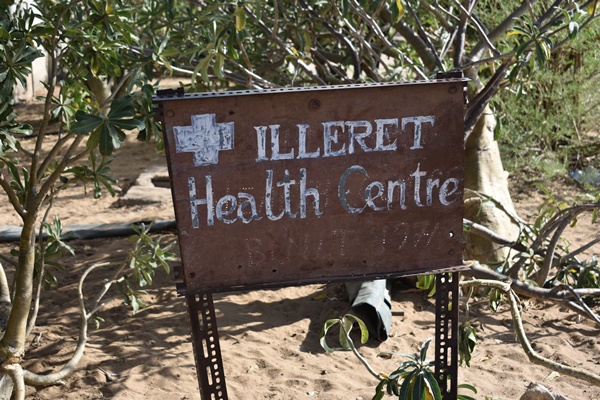
The Ileret Health Centre. Photo credit Cheng-Wen Hsu
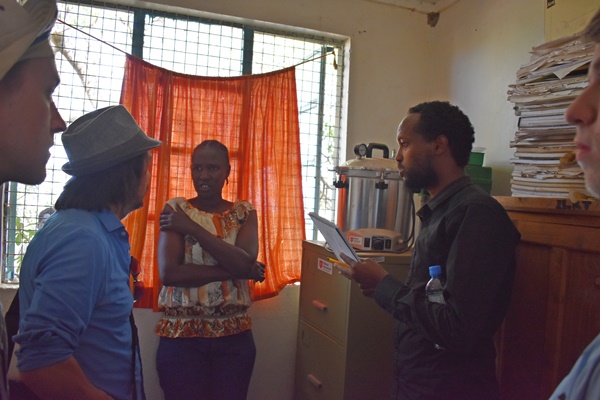
Rodrigo (left) and Keena(right) talk to the head of the clinic, Beatrice(middle), about the electric sterilizer. Photo credit Cheng-Wen Hsu
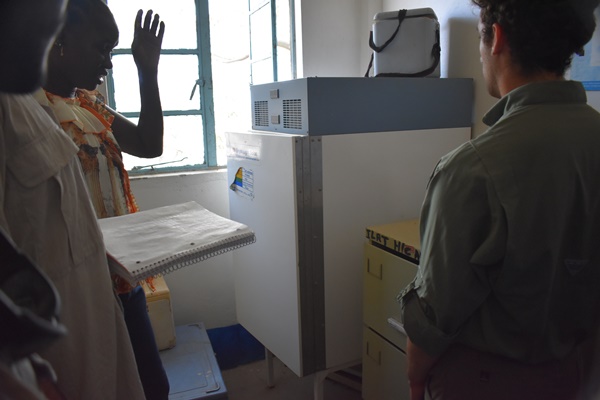
Students taking notes on the broken refrigeration system. Photo credit Cheng-Wen Hsu
At the next stop, the team was welcomed warmly by staff of the primary school and toured the facilities. The group made assessments on classroom buildings with broken structures, outdated latrines, the school dining hall, and solar panel system in place. Instantly, they jumped into action to propose long-term infrastructural changes as well as solutions of classroom arrangements for the safety of students.
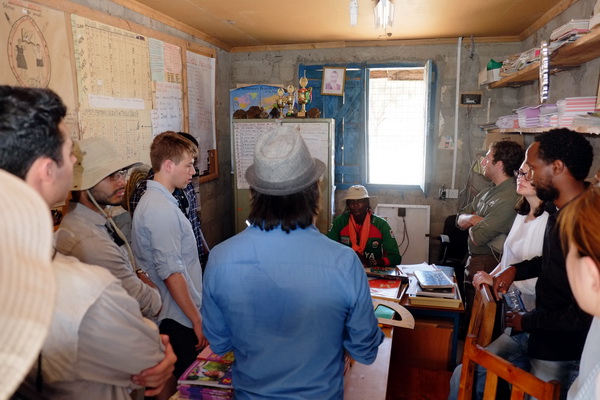
The team meets with Madame Hilda, the principal of the primary school. Photo credit Deming Yang
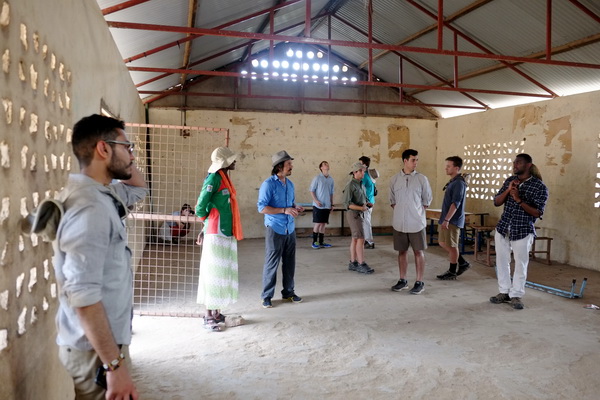
The group looks at the dining hall that was abandoned after food supplements from the government stopped arriving to the school for students 3 months ago. From left to right (Giancarlos, Wen, Madame Hilda, Professor Rodrigo Pena-Lang, Jake, Joe, Nick, Brent, Nick, and TA Julian). Photo credit Deming Yang
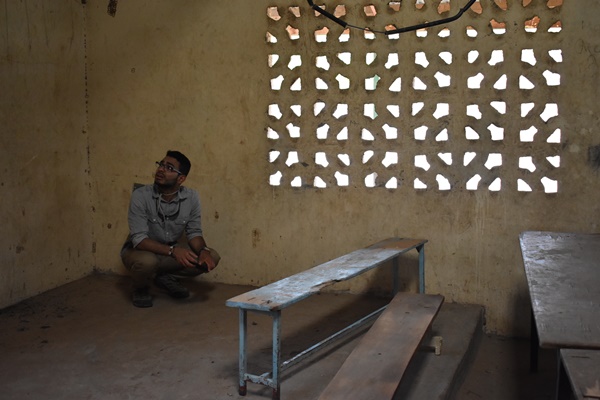
Giancarlos surveys the building. Photo credit Cheng-Wen Hsu
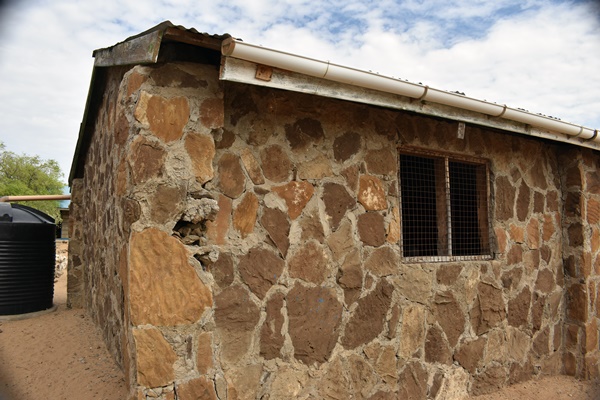
A structural issue at outer wall of the classroom building. Photo credit Cheng-Wen Hsu
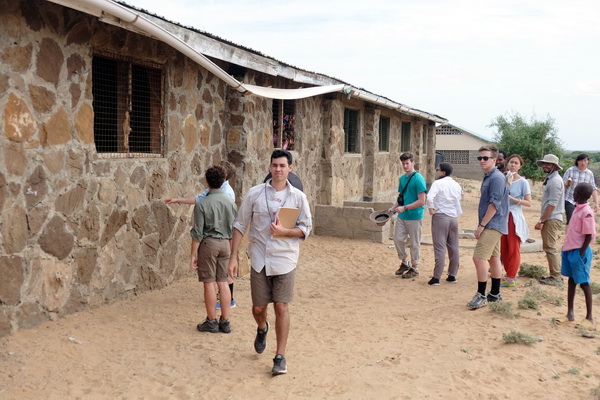
As seen, one of the gutter systems is falling apart and some of the building structure is breaking down. Photo credit Deming Yang
As the team made plans, so did the students of the primary school: as soon as they were released from class, the young children clamored over the Global Innovation group grabbing their hands and hair, and conversating in mixes of Swahili and English.
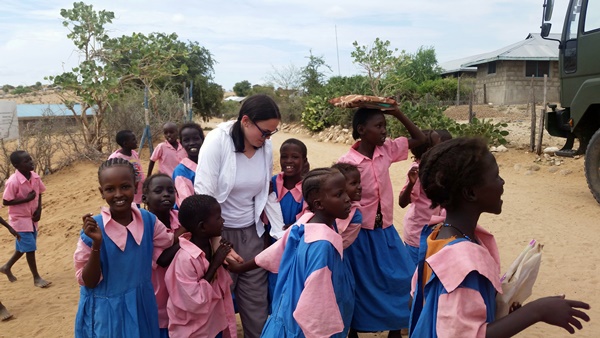
Saffron is swarmed by a group of young girls that teach her hand games, the kangaroo hop, show off pop dances, and sing “Papa Outai” by Stromae
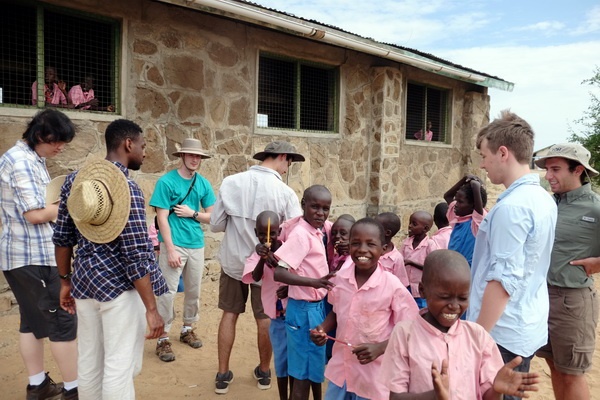
Smile! Photo credit Deming Yang
The students then opted to take a 3km walk back to the facility where they looked at the availability of local materials and got a greater understanding of the landscape around them. Afterwards a deep discussion on new solutions for the clinic and school arose: redirecting the circuit of the photovoltaic system, building tables for school students to use a more stable facility, using plastic and other waste to be repurposed as musical instruments, and innovations for refrigerating vaccines and other medicines.
That night, a record breaking 8-hr rainstorm fell upon Ileret which temporarily disabled the students from returning to outside site visits. However, their time in the facility was well spent learning different systems of water treatment, hydrology, and waste water infrastructure. From their new gained knowledge, students had conceptualized a new waste water treatment that could be created for the clinic using minimal materials, new methods of conducting large and small scale rainwater collection, and the possibility of using bone charcoal as a water filtration for locals.
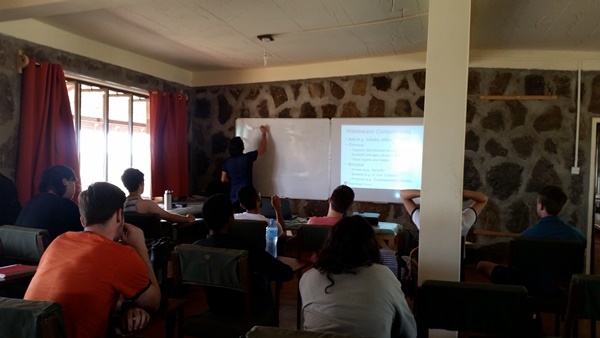
A lecture on wastewater collection and treatment in preparation for the challenges that are arising in the town
To end the day, students played a fun but competitive game to bond and connect with TBI staff.
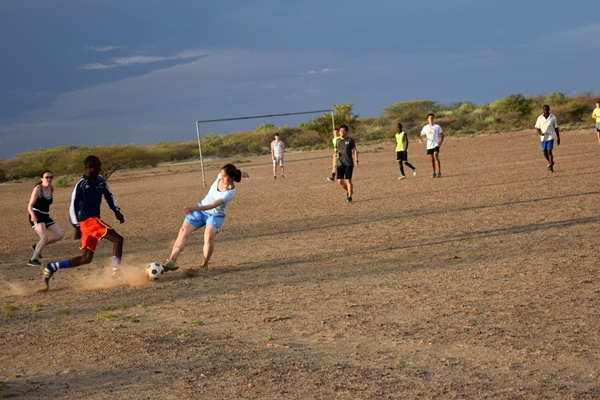
Wen slides in for the steal! Photo credit Giancarlos Llanos Romero

The Global Innovation team streaks across the field! Photo credit Cheng-Wen Hsu
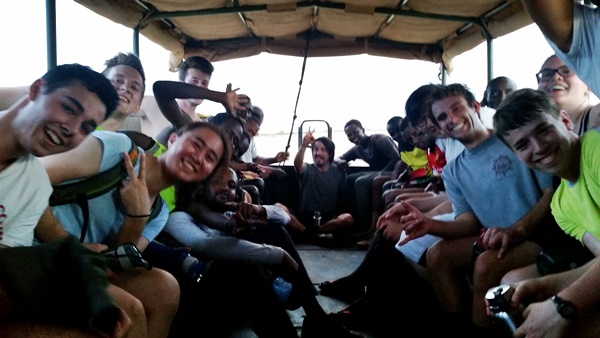
End of game!
From the site visits, the consequence of ignoring sustainability and long term impact of one’s implementations became clear. Many of the current problems that the clinic and school face are due to lack of maintenance by large organizations leading to failed technology and infrastructure. One reoccurring instance involved the breakdown of batteries in the solar panel systems for both facilities where improper or obsolete equipment has been the cause of insufficient energy for over a year. This is an exhaustive problem as the Ileret town clinic is one of the only sources of health aid within a 40 km radius with a staff of less than a dozen workers handling 50 patients on average. With only 12 hours of sunlight, the clinic workers are subjected to using lights from their mobile phones to treat patients late in the evenings.
As the students attack these challenges, the lack of available material in Ileret will provide difficulty in their proposals. This forces the group to adjust in providing either theoretical or practical solutions to these problems.
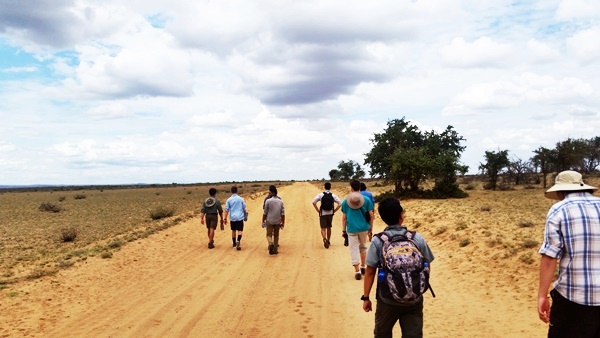
A long but promising road ahead





